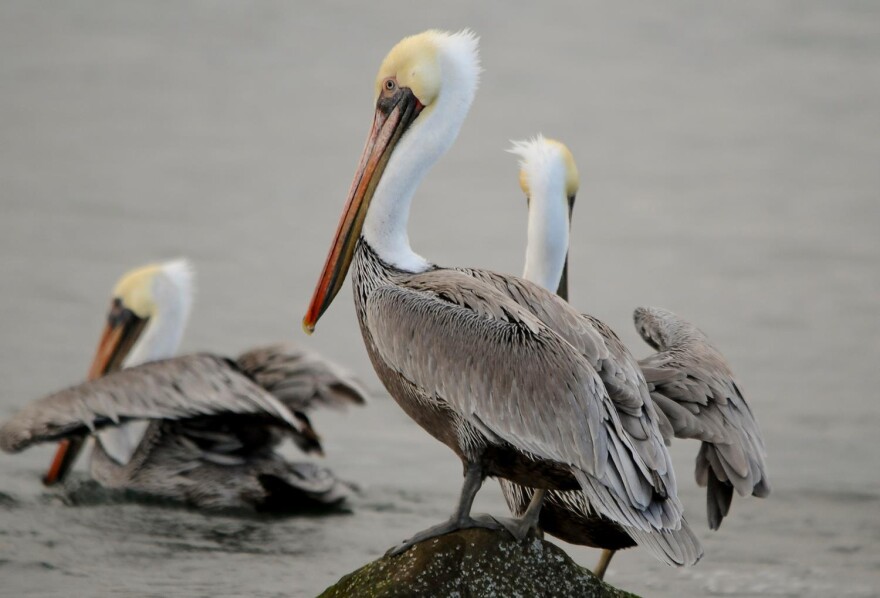Every other Friday, the Outside/In podcast team answers one listener question about the natural world.
This week’s question comes from Rebecca, from the Bay Area of California.
"I’m sitting out here and watching the geese fly overhead and it made me wonder - does the heavy smoke from all these wildfires in Oregon and California have an impact on migrating birds? Just curious! Hopefully it doesn’t."
You’ve got to admire Rebecca’s optimism here, but going into this question I wasn’t feeling too hopeful myself.
And yet, it’s worth noting that wildfire isn’t always a bad thing for birds. Some species of birds (as well as other types of animals and plants) have adapted to living in areas where fire is a normal and regular part of the ecosystem.
For example, the black-backed woodpecker has adapted to nest in the trunks of burned trees. It’s their niche - and without any fire, they’d have a harder time surviving.
In other words, the right mix of wildfire in a given area can actually increase biodiversity over time.
But the increasingly common ‘megafires’ we see today are hotter and more destructive than typical wildfire. That means the benefits for wildlife are less clear and the costs are much, much higher.
And while some birds do benefit from wildfire in the landscape, all birds are vulnerable to smoke inhalation.
Bird Breath
Olivia Sanderfoot is a PhD candidate at the University of Washington School of Environmental and Forest Sciences. Her work focuses on how wildfire smoke and urban air pollution affect birds.
Birds, she says, don’t breathe like humans.
“They have rigid lungs that don’t expand or contract, instead their respiration is supported by a system of air sacs that constantly pushes fresh air into their lungs.”
It’s hard to explain, but if you’re the musical type this analogy might help: Those air sacs work a bit like the bag on a set of bagpipes.

Or, alternatively, like the cheeks of didgeridoo players who use a technique called ‘circular breathing’ in order to push air out of the instrument even while breathing in through their nose.
The takeaway here is that - breath for breath - those air sacs allow birds to take in more air and more oxygen than humans do.
That’s great for sustaining intense physical activity, like flight.
Unfortunately, it also means they’re more vulnerable to toxic gasses and fine particular matter, like carbon monoxide, dust, and pollution.
Ever heard the phrase, “canary in the coal mine?” Birds were used as early air quality detection systems for a reason: If something in the air is bad for us humans, chances are it’s worse for the birds.
And to be clear: wildfire smoke is definitely bad for human health.

Yellow Skies
So we’ve established that smoke is bad for bird health. But the tougher question to answer is: are we able to see those ill effects at the level of population and/or migration?
I’m sorry to say that yes, we can.
Anni Yang is an assistant professor in the geography and environmental sustainability departments at the University of Oklahoma.
She was in Fort Collins, Colorado in 2020. In September of that year, the August Complex became the largest wildfire ever recorded in California history.
“Those yellow skies… the smoke was everywhere during that time period,” Yang says.
Around the same time there were news reports in the Southwestern U.S. about people suddenly finding lots of dead birds - what scientists call a “mass mortality event.”
Many of them were tropical songbirds in the process of fall migration.
Anni and her colleagues started collecting data from the educational citizen science app called iNaturalist.
They looked at the number of reports, the number of dead birds found per report, as well as where and when they were found. They cross-referenced that with geographical data about where the wildfire and wildfire smoke was occurring during those times.
The researchers found a strong correlation between the toxic air and the mass mortality event: evidence that wildfire smoke was partially to blame for the increased number of bird deaths, though they also pointed towards an early season snowstorm that likely contributed to the problem.
“I definitely think the wildfire will impact the health of the birds,” Annie says. “It will cause direct death, and also habitat loss.”
A hazy future
In a recent study by the U.S. Geological Survey, researchers were able to get a real-time view of how wildfire smoke impacted the migration of four Tule Greater White-fronted Geese (a Species of Special Concern).
The geese were actively migrating south during the intense 2020 wildfire season. On average, the migration took them twice as long and covered 470 more miles than usual.
The birds were not only forced to pause migration at times; they also had to rest outside their usual habitats and stopover sites, and change course or gain elevation to try and fly over the thickest smoke.
Because migration is so energy-intensive, that kind of disruption can kill a bird or lower reproduction rates (birds who don't have enough calories for the journey might not make it) though the four geese tracked in the USGS study did all reach their eventual destination.
But smoke isn’t just impacting bird health - it’s also obscuring our own ability to witness - and potentially research - bird activity.
One of Olivia Sanderfoot’s latest studies utilized another app - eBird - in order to track how wildfire smoke impacts the observation of birds.
Not surprisingly, reported bird sightings for many species went down when the air was smokiest - but it also went up for some species as well. Olivia thinks this is possibly because some birds are forced to land more often or forage closer to home during wildfire smoke events.
Ultimately, the study is further evidence that both human and bird behavior is being altered by thick wildfire smoke.
With bigger, hotter fires happening more often because of climate change, these effects are likely to get worse.
One way you can help is by contributing to the data pool, as these studies have relied heavily on crowdsourced citizen science.
Sharing your nature observations on an app may feel like small potatoes in the face of climate change, but you’re not alone: citizen science is an example of collective action.
“It will really help with pushing forward with the research,” Anni Yang says. “And with getting more people interested in science, which will help to make our planet better.”
If you’d like to submit a question to the Outside/In team, you can record it as a voice memo on your smartphone and send it to outsidein@nhpr.org, OR call the hotline, 1-844-GO-OTTER.
Outside/In is a podcast! Subscribe wherever you get yours.




